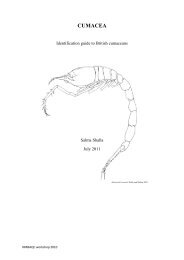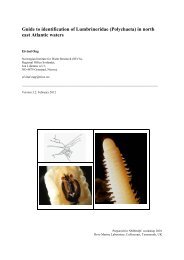s A Field Guide to the British Seaweeds - NMBAQC
s A Field Guide to the British Seaweeds - NMBAQC
s A Field Guide to the British Seaweeds - NMBAQC
Create successful ePaper yourself
Turn your PDF publications into a flip-book with our unique Google optimized e-Paper software.
Desmarestia aculeata<br />
Frond often quite narrow, generally<br />
less than 2mm, flattened, coarse and<br />
reddy brown in colour. The long main<br />
axis is highly and regularly alternately<br />
branched and can grow up <strong>to</strong> 180cm.<br />
Side branches may be quite long but<br />
in older plants branchlets appears<br />
short, spine-like and look serrated.<br />
Found most frequently in <strong>the</strong> lower<br />
lit<strong>to</strong>ral particularly in sandy or<br />
unstable substrate bot<strong>to</strong>med pools<br />
Desmarestia in its natural<br />
habitat, with a distinct<br />
serrated appearance in<br />
older plants and with <strong>the</strong><br />
long main axis clo<strong>the</strong>d in<br />
long branchlets as seen in<br />
younger plants<br />
Dictyosiphon foeniculaceus<br />
Plant quite fine and delicate and light<br />
brown in colour. Branches very irregular<br />
and generally from main axis appearing<br />
as straight thick filaments or filiform and<br />
growing up <strong>to</strong> 70cm long. Filaments<br />
often have an all-over covering of fine<br />
hairs. Found most frequently in <strong>the</strong> mid<br />
lit<strong>to</strong>ral area within wide shallow<br />
rockpools often with sandy bot<strong>to</strong>m. May<br />
be confused with Chordaria sp.<br />
Dictyosiphon in natural habitat




